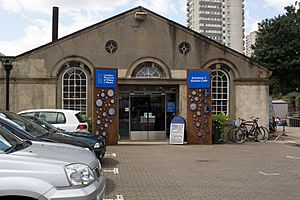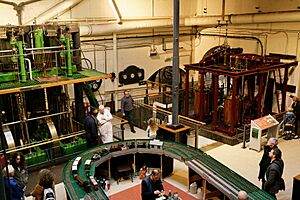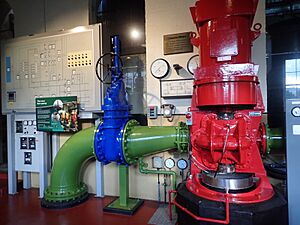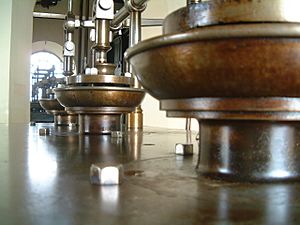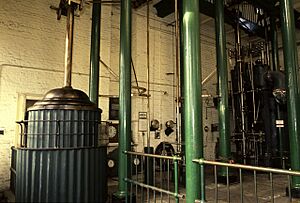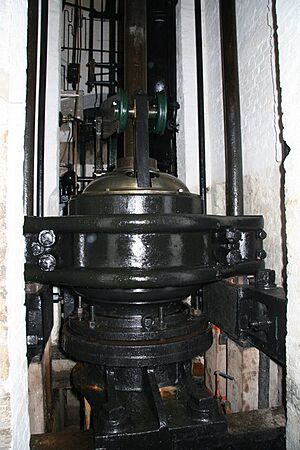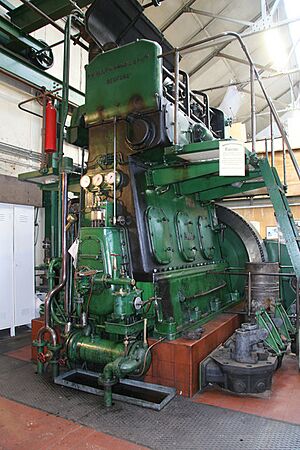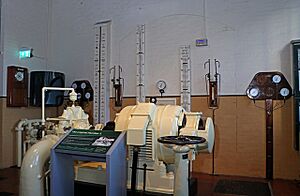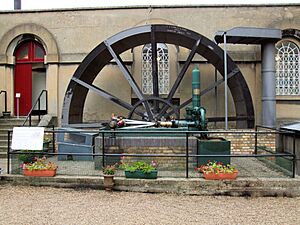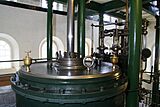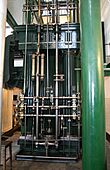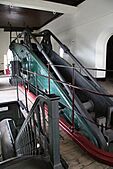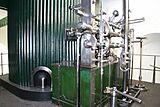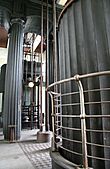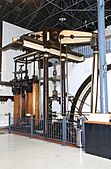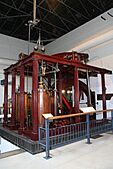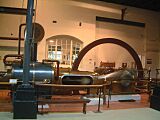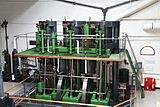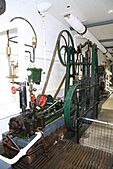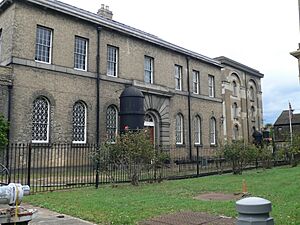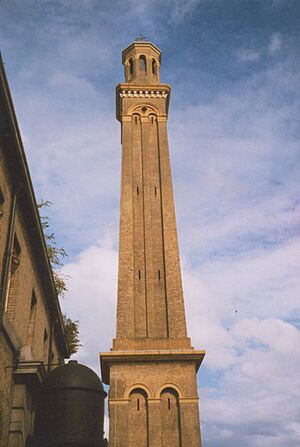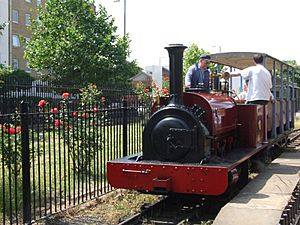- This page was last modified on 17 October 2025, at 10:18. Suggest an edit.
London Museum of Water & Steam facts for kids
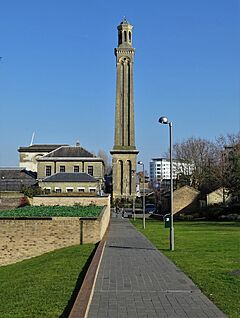
The stand-pipe tower and engine houses
|
|
| Lua error in Module:Location_map at line 420: attempt to index field 'wikibase' (a nil value). | |
| Established | 1975 |
|---|---|
| Location | Brentford, England |
| Public transit access | |
The London Museum of Water & Steam is a cool museum that started in 1975. It was first called the Kew Bridge Steam Museum. In 2014, it got a new name and a big makeover!
This museum is located at the old Kew Bridge Pumping Station in Brentford, West London, England. It's right by Kew Bridge and the River Thames. The main stars of the museum are its amazing collection of old steam engines. These engines were used to pump water and were built between 1820 and 1910.
The museum is home to the world's largest collection of Cornish engines. This includes the Grand Junction 90 inch engine, which was once the biggest working beam engine in the world! There's also the 100 inch engine, which is the largest single-cylinder beam engine still around. The museum is also an important stop on the European Route of Industrial Heritage.
Contents
Discovering the Museum's Past
The Kew Bridge Pumping Station first opened in 1838. It was built by the Grand Junction Waterworks Company. They decided to move from an older station because the water quality was not good. This new station first supplied drinking water to areas like Paddington and Kensington. Soon, it also helped Ealing and, by the 1900s, most of West London.
Over the years, the site grew. By 1944, it had six steam pumping engines and four diesel pumps. That year, new electric pumps were put in, and the steam engines stopped their regular work. However, two steam engines were kept ready in case they were needed. In 1958, the Harvey & Co. 100 inch engine had its last public run. This was the final time steam power pumped drinking water at the site.
The Metropolitan Water Board decided not to get rid of these old steam engines. They wanted to save them for a future museum. This idea came true in 1974 when the Kew Bridge Engines Trust was formed. This group of volunteers helped restore the engines.
Soon after, the museum opened to the public. One by one, the old pumping engines were fixed up and made to work again with steam. The 1820 Boulton & Watt engine, the oldest one, was the first to run on steam again in 1975. The Grand Junction 90 inch engine followed in 1976. The 1838 Maudslay engine was restored in 1985. Other old pumping engines from different places were also brought to the museum.
In 1997, the museum won an Engineering Heritage Award. This award came from the American Society of Mechanical Engineers (ASME) and Britain's Institute of Mechanical Engineers (IMechE). In 1999, the UK government said Kew Bridge was "the most important historic site of the water supply industry in Britain". In 2008, the museum won another award for fixing the 1856 Bull engine. This engine started working again in May 2008.
The Museum Today
In March 2014, the museum reopened after a big £2.45 million upgrade. Most of the money came from the National Lottery Heritage Fund. Other groups like Thames Water and Hounslow London Borough Council also helped. Now, the museum tells the full story of London's water supply. It covers everything from Roman times to today. You can see this story through many displays and old items.
The Kew Bridge Engine Trust and Water Supply Museum Limited has three main goals:
- To fix and keep the five historic beam engines at the Kew Bridge site.
- To add other important water pumping engines to the collection.
- To create a museum about London's water supply.
Today, the museum is famous around the world for its working steam pumping engines. It reminds us of the many pumping stations that used to be all over London and the UK. The museum also has learning programs for schools. It also keeps a collection of old items related to steam and water.
Between 1975 and 2008, four of the museum's five original Cornish engines were made to work again. However, in recent years, some have not been running. The Grand Junction 90 inch engine has not been steamed publicly since 2015. There have also been problems with the Great Engine House where this engine and the 100 inch engine are kept. In 2017, the Maudslay engine was found to be unsafe to run. In 2019, the Boulton & Watt engine also stopped working. It was fixed and started steaming again in 2025.
Problems with the engines got worse during the COVID-19 lockdowns in 2020-21. Also, the museum's gas-fired Lancashire boiler broke in 2022. This stopped all the museum's stationary steam engines for 18 months until a new boiler was found. Now, the museum tries to steam its other engines regularly. They used to run every weekend, but now the "Steam Ups" happen once a month.
In 2025, the museum received a £2.6 million grant. This money from the Department for Culture, Media and Sport will help fix the Great Engine House. The museum says this is very important for saving its historic engines and keeping the museum going.
Amazing Engines at the Museum
The museum has the world's largest collection of Cornish cycle beam engines. After it was fixed in 1976, the Grand Junction engine was the biggest working beam engine in the world. This huge machine is over 40 feet tall and weighs about 250 tons! Charles Dickens even called it "a monster." This engine is one of many Cornish engines put in at Kew Bridge. They were all used to pump water from the River Thames to homes and businesses in West London. They worked regularly until the mid-1940s.
A Look at Engine History
The first engine to pump water at Kew Bridge was a new one by Maudslay, Sons and Field. It started working when the station opened in 1838. Two older engines by Boulton & Watt joined it. These had been built in 1820 for another waterworks. When that old waterworks closed, the two Boulton & Watt engines were moved to Kew Bridge. All three engines pumped water straight from the River Thames.
In 1845, the company decided to pump more water. They built a new reservoir and added filter beds at Kew. They also built the biggest waterworks engine in the world at that time. This became known as the Grand Junction Engine. New Cornish boilers were installed. The older engines were changed to work with higher steam pressure. They were updated to work like the new engine. Two smaller engines were also added to pump water from the river into the filter beds.
After a new law in 1852, the company started getting water from further upriver, at Hampton. The water was pumped through underground pipes to Kew. This meant the smaller engines were no longer needed. A Bull engine was put in their place in 1859. It pumped water to Campden Hill. As more water was needed, another large engine, the 100 inch engine, was added in 1871. This almost doubled the station's pumping power.
All six engines kept pumping water well into the 1900s. A Worthington steam engine was added in 1891. From 1934, four W. H. Allen diesel engines also helped pump water.
In 1942, during wartime, electric pumps were installed at Kew Bridge. This saved labor and coal, which were in short supply. Six electric pumps were put in. The Cornish engines were then stopped. The 100 inch engine was the last to work regularly until 1944.
Afterwards, the 100 inch and the Bull engine were kept ready for use until 1958. Then, they were officially stopped. The old boilers were removed, and the chimney was taken down. The large filter beds and reservoirs nearby were also filled in. Much of the land was sold for houses.
Even though one engine was scrapped in 1946, the others were saved by the Metropolitan Water Board. The diesel engines worked until 1985. One of them is still at the museum. The electric pumps were stopped in 1986, with one set saved. New automated pumps took their place. In 2012, these pumps were also stopped. Today, water is still pumped from Kew Bridge, but the equipment is deep underground.
Engines in the Collection
Besides the original Kew Bridge engines, the museum has other working steam engines. These are often run for visitors. The museum also has many other items related to water supply.
Here are some of the main steam pumping engines you can see:
Cornish engines (original to Kew Bridge):
- 1820 Boulton & Watt engine (64 inch)
- 1838 Maudslay engine (65 inch)
- 1846 Sandys, Carne and Vivyan engine - the Grand Junction 90 inch engine
- 1857 Harvey & Co. Bull engine (70 inch)
- 1869 Harvey & Co. engine - the 100 inch engine
Other steam engines (brought from other places):
- An 1860 Easton and Amos engine (from Northampton)
- The Dancer's End engine (from Lord Rothschild's estate)
- The 1910 Waddon engine (these were the last working steam engines in UK waterworks when they stopped in 1983)
- A c. 1910 Hathorn Davey & Co. triple expansion engine (from Newmarket)
- A small 1895 Benham & Co. pumping engine (from Salisbury)
You can also see a working 1902 water wheel. It came from the Duke of Somerset's estate in Wiltshire. It used to pump water from the River Frome. The museum also runs an 1860 Shand Mason Fire Engine on special days.
Gallery
- The Cornish Engines
- Rotative Engines
Exploring the Museum Site
The museum site has many important buildings. The original Engine House, built in 1837, is where the Bull, Boulton & Watt, and Maudslay engines are. The Great Engine House, built in 1845 and 1869, holds the 90 inch and 100 inch engines. Both are very special historic buildings.
The Boiler House, where the other steam engines are now, was built in 1837. A second boiler house was added in the 1850s. All these buildings are also important historic sites. There's also a working forge (a place where metal is shaped with heat) and a workshop.
Until the late 1950s, the site had several reservoirs and filter beds. Water from the Thames was pumped here. It went through different reservoirs and filter beds to be cleaned. Then, the clean water went into the engines' pumps.
The Tall Tower
The museum's most noticeable feature is its 200-foot tall Victorian stand-pipe tower. This is not a chimney! It holds two systems of tall pipes. Water was pumped through these pipes before it went into the main water supply for homes. This brick tower was built in 1867. It is also a very special historic building. The tower is not often open to the public.
The waterworks used to have a chimney, but it was taken down in the late 1950s.
The Museum Railway
The museum has a small narrow-gauge railway. In 2009, a new steam locomotive named "Thomas Wicksteed" started running on it. The railway is 400 yards long. Passenger trains run on weekends and special event days.
This railway was not part of the original waterworks. But it was inspired by similar railways at other large waterworks in the UK. For example, the Metropolitan Water Board Railway used to run between Hampton and Kempton Park. A small part of that railway is now the Kempton Steam Railway. The London Museum of Water & Steam has helped the Kempton Steam Railway a lot.
The original waterworks at Kew Bridge did have an underground railway tunnel. It moved coal from the river to the boiler houses. This tunnel is still there, but visitors cannot go into it.
Locomotives at the Museum
| Locomotive Name | Locomotive Type | Year Built | Builder | Works Number | Notes |
|---|---|---|---|---|---|
| Thomas Wicksteed | 0-4-0ST | 2009 | Hunslet | 3906 | Steam locomotive, a type called Kerr Stuart Wren class. |
| Alister | 4wDM | 1958 | Lister-Blackstone | 44052 | Diesel locomotive, used to be at Bala Lake Railway. |
Seen on TV
The museum has been a filming location for many TV shows and movies. These include The Kenny Everett Video Show, EastEnders, The Bill, and Doctor Who ("Remembrance of the Daleks"). It was also used for the opening of the BBC music show Top of the Pops from 1991 to 1995. After reopening in 2014, it was used for an episode of the TV series PREMature.
See Also
- Crossness Pumping Station – another steam-powered pumping station in Southeast London
- Kempton Park Steam Engines
- Kempton Steam Railway
- Metropolitan Water Board Railway
- Pumping station
- The Musical Museum is nearby

